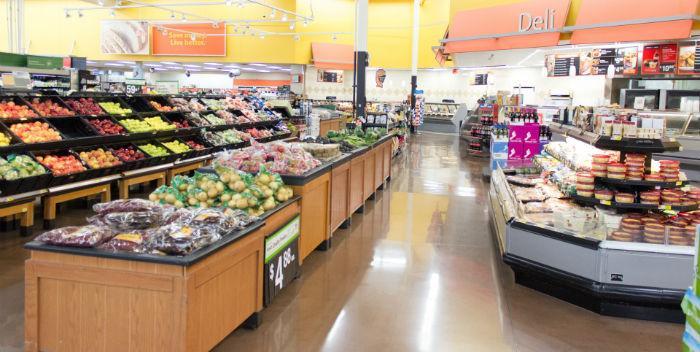 This article focuses on the contribution that indirect refrigeration systems can make in the protection of the environment.
This article focuses on the contribution that indirect refrigeration systems can make in the protection of the environment.
by Eng. Ernesto Sanguinetti R.*
While indirect cooling systems are not new because they have been used since the time "artificial ice" was first made, today they have found a remarkable expansion for two main reasons:
1.-The global concern about the harmful effects on the Earth's atmosphere produced by synthetic refrigerants such as Carbonated Fluoro Chlorine (CFC), Carbonated Hydro Chlorine Fluoro (HCFC) and Carbonated Hydro Fluoro (HFC).
2.-The increase in energy consumption, parallel to the increase in its cost.
The first reason is promoting the use of natural refrigerants such as ammonia (NH3), carbon dioxide (CO2), HC hydrocarbons (Propane, Isobutane and others), some new synthetic refrigerants such as Hydro Fluoro Olefins (HFO), as well as mixtures of HFO with HFC, HFO with HC.
All this regulation of elimination of harmful refrigerants is contemplated in the so-called Montreal Protocol and its amendments (the last in Kigali-Rwanda of 2016) and the Kyoto Protocol with its amendments (the last COP21 in Paris-France of 2015) to eliminate those refrigerants that deteriorate the ozone layer and that produce global warming or "greenhouse effect" respectively.
The second reason is promoting the use of more efficient refrigeration machines, to spend less energy achieving the same or greater refrigerant effect, which is a challenge for manufacturers of refrigeration and air conditioning equipment. But it is also encouraging the use of liquid secondary refrigerants because the energy spent pumping a liquid is much less than that spent on a compressor that compresses refrigerant in refrigeration equipment. If an efficient refrigeration unit is combined to cool a secondary fluid, the resulting positive effect is greater.
Direct and indirect cooling systems
Direct systems: are those that cool or freeze a substance by the "evaporation" of the refrigerant fluid that circulates in a closed circuit by a refrigeration equipment, usually of the type by vapor compression. In the diagram below, the refrigerant circulating inside the coil of tubes connected to a condensing unit directly cools the liquid contained in the insulated vessel.
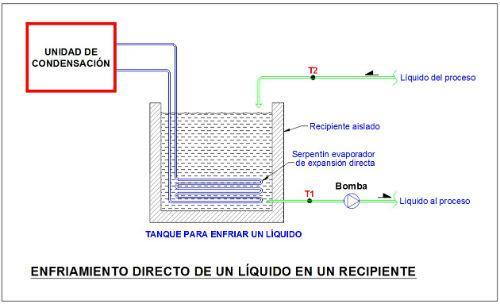
Figure 1.
Indirect systems: are those that cool or freeze a substance by the influence of a fluid that has previously been cooled by the refrigerant that "evaporates" usually in a vapor compression cooling system. In the diagram below, the refrigerant circulating through the coil of tubes connected to the condensing unit directly cools the water or glycol contained in the insulated vessel No. 1 and this fluid indirectly cools the liquid contained in the insulated container No. 2 circulating through another coil.
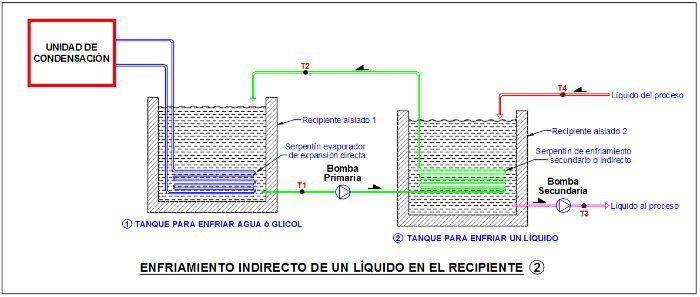
Figure 2.
The indirect cooling system is widely used in milk cooling plants, in fishing vessels that use recirculated seawater (RSW), in the manufacture of ice in blocks or bars, in ice skating rinks, in air conditioning using water chillers or "chillers". Now it is being given more importance, being used more and more in agro-industrial plants and especially in supermarkets. The indirect cooling system uses what we call "Secondary Refrigerants", of which we will list the most important and explain some of them.
Main secondary refrigerants used
A. Water: It is widely used because it has high specific heat, good thermal conductivity, is not toxic, does not harm the environment, is available in abundance( but depends on the area), is relatively cheap. Its drawbacks: it must be as soft as possible (it must be treated if it has many magnesium and calcium salts), free of sand and other solids (it must be filtered) but the biggest of all is that it must be used in applications above 0 ° C because it freezes.
B. Brines: They are used in many applications where liquid must be kept at temperatures below 0°C. They are mixtures of water with salt diluted evenly throughout the liquid mass.
The mixture of water with Sodium Chloride (NaCl) which is the common salt is used, being called the mixture Sodium Chloride Brine, which is not toxic. The more salt is added to the water, the mixture or solution decreases its freezing point, reaching the maximum concentration where the lowest possible temperature or eutectic point is reached and the concentration is called eutectic concentration (-21.1°C with 23% by weight of salt). It is characterized because if more salt is added to the solution, the freezing temperature begins to rise again. It has the disadvantage that it is corrosive so neutralizing substances must be applied to avoid that effect. The behavior of Sodium Chloride Brine is shown graphically:
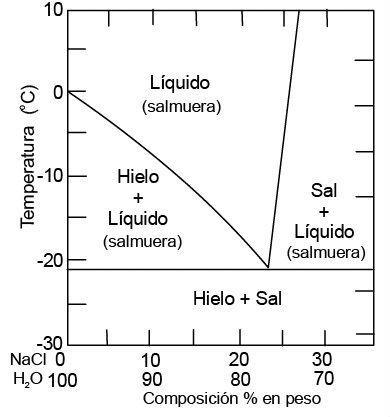
Figure 3.
The mixture of water with Calcium Chloride (CaCl2) is used, which is a granulated, hygroscopic and bitter salt, being called the mixture Calcium Chloride Brine. Similarly, the more salt is added to the water, its freezing point decreases, reaching the eutectic point, the maximum concentration being the eutectic concentration (-55°C with 30% by weight of salt). Likewise, if more salt is added, the freezing temperature begins to rise again, having a behavior similar to the previous graph of the Sodium Chloride Brine but lower temperatures are achieved. It is also corrosive so neutralizing substances must be applied to avoid that effect.
C. Glycols: Cigars are rarely used, it is normal to mix them with water. They are divalent alcohols because they have two groups of oxydriles in their molecules and are somewhat sweet in taste. When mixed with water they become corrosive so they are marketed with built-in inhibitors.
There is ethylene glycol or ethylenic glycol, which is toxic by ingestion and inhalation and therefore in food applications is prohibited, being used a lot as an antifreeze, for example, in radiators of cars, trucks. In concentrations up to 50% by weight you can freeze products at -35°C because their eutectic point is reached at -67°C with a concentration by weight of 70%.
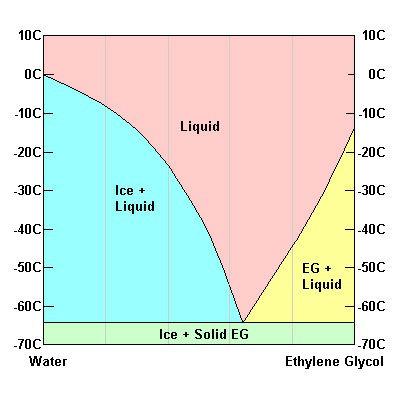
Figure 4.
Propylene glycol or propylene glycol is used more, which is viscous, biodegradable, little toxic by ingestion and inhalation, so it is used in food applications. In concentrations up to 50% by weight, products can be frozen at -35°C because their behavior is similar to ethylene glycol.
D. Alcohols: They are cryoscopic organic compounds (they lower the freezing temperature of water if mixed with it), the best known being Methyl alcohol that is flammable and toxic that excludes it from applications that have to do with food, Ethyl alcohol that is colorless and mixes with water in any proportion and of course is toxic can be applied to food refrigeration, is volatile and freezes at -114°C; Glycerin which is a viscous, colorless and sweet liquid, is mixed with water in all proportions, frozen at -40°C.
E. Carbon Dioxide: It has been increasingly used in the Food Cold system of supermarkets. We schematically show the use of CO2 as a secondary refrigerant when it is previously "cooled" by another refrigerant to be pumped as a liquid and indirectly cool a cold room or food preservation showcases. It's an application where what we commonly call an evaporator is actually a cooler, because there's no refrigerant evaporation. It is used in medium/high temperature applications.
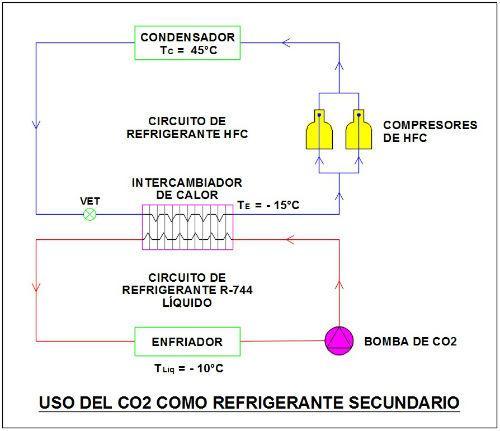
Figure 5.
In cascade cooling it can also be considered that indirect cooling is used even though the 2 fluids that are used evaporate. It is increasingly being used in the refrigeration of supermarkets or food refrigeration systems.
As a reference we show schematically the use of CO2 (R-744) as a secondary refrigerant "in cascade" with another HFC refrigerant to fulfill a subcritical thermodynamic cycle. In this case the CO2 evaporator is used for medium/low temperature applications.
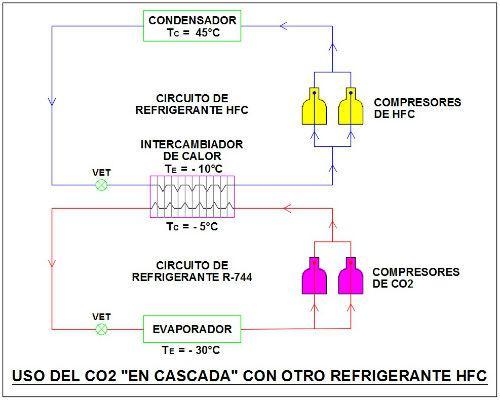
Figure 6.
Ammonia, which is a refrigerant that does not damage the ozone layer (ODP = 0), nor does it produce global warming (GWP = 0) and also has excellent thermodynamic properties, is not an advisable refrigerant for use in direct refrigeration of food, so in agribusiness and supermarkets it is beginning to be used as a Primary Refrigerant as a replacement for an HFC to cool "cascade" to a Secondary Refrigerant such as CO2 (ODP = 0, GWP = 1) that cools food products. For safety, ammonia is confined to the engine room away from the public and food products.
The use of these two refrigerants that do not cause damage to the Earth's atmosphere is schematically shown, that is, their properties are used to produce refrigeration and at the same time protect the environment.
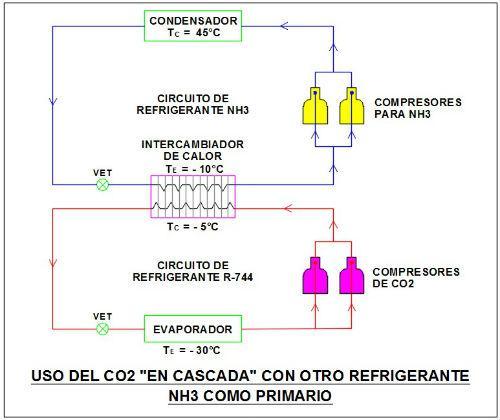
Figure 7.
* Eng. Ernesto Sanguinetti R.- Engineering Division Manager-Cold Import S.A. Lima, Peru.














